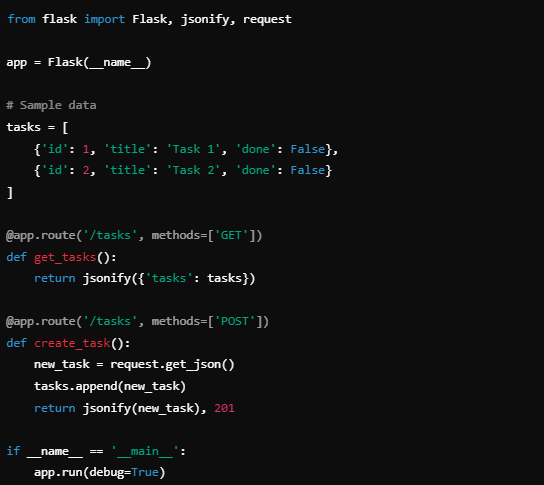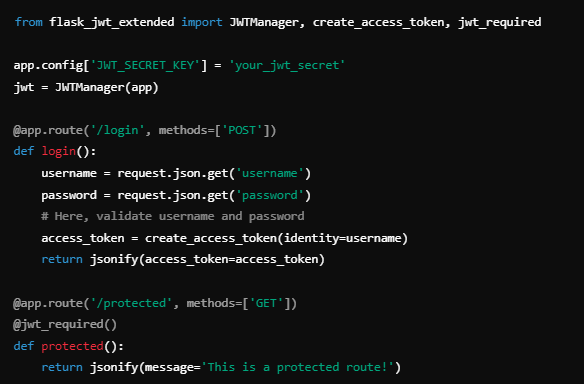
In today's digital world, RESTful APIs are key. They allow smooth communication between client and server applications. Python is widely favored for its clarity and ease of use. So, it is a top choice for building RESTful APIs. This article covers the key aspects of creating RESTful APIs with Python. It explains essential concepts, tools, and best practices. The goal is to help developers design efficient, scalable APIs.
Table Of Contents
- Understanding RESTful APIs
- Choosing the Right Framework
- Creating a Simple RESTful API with Flask
- Implementing Authentication and Authorization
- Versioning Your API
- Conclusion
Understanding RESTful APIs
RESTful APIs are architectural styles that use HTTP requests to manage data. They are stateless. Each client request has all the info the server needs to fulfill it. This characteristic leads to greater scalability and performance.
Key Principles of REST:
- Statelessness: Each API call is independent; the server does not store client context.
- Resource-Based: Resources (e.g., users, products) are identified by URIs (Uniform Resource Identifiers).
- Use of HTTP Methods: Common HTTP methods include:
- GET: Retrieve data from the server.
- POST: Create a new resource.
- PUT: Update an existing resource.
- DELETE: Remove a resource.
Data Format: RESTful APIs usually use JSON for data exchange. It's lightweight and easy to read.
Choosing the Right Framework
Python offers several frameworks for building RESTful APIs, each with unique features. Here are three popular options:
Flask
- Lightweight and Flexible: Flask is a micro-framework. It enables developers to create applications rapidly.
- Extensible: It has many extensions to add features, like database and user login.
- Ideal for Prototypes: Flask is perfect for small to medium-sized applications and prototypes.
Django REST Framework (DRF)
- Full-Featured: DRF extends Django, providing a robust toolkit for building APIs.
- It has built-in features: serialization, authentication, and viewsets. They simplify managing complex apps.
- Great for Large Projects: DRF is perfect for large apps. They need scalability and maintainability.
FastAPI
- Asynchronous: FastAPI is designed for high performance and supports asynchronous programming.
- Automatic Documentation: It automatically generates interactive API documentation using Swagger and ReDoc.
- Type Hints: FastAPI leverages Python type hints for better code quality and validation.
Creating a Simple RESTful API with Flask
Step-by-Step Guide
Setting Up Flask:
- Install Flask using pip:
Creating a Basic API:
- Generate a file named app.py and include the following code:
Running the API:
- Execute the command:
- Access the API at http://127.0.0.1:5000/tasks to retrieve tasks.
Testing the API
- Use tools like Postman or cURL to test your API endpoints. For example, send a POST request to http://127.0.0.1:5000/tasks with a JSON body to add a new task.
Implementing Authentication and Authorization
Security is critical when building APIs. Implementing authentication and authorization ensures that only authorized users can access specific resources.
Common Authentication Methods
- Basic Authentication entails transmitting a username and password with every request.
- Token-Based Authentication: After a successful login, users get a token. It must be in all future requests.
- OAuth2: A more secure and scalable method often used for third-party integrations.
Example with Flask-JWT-Extended
- Install Flask-JWT-Extended:
- Add Authentication to Your API:
Versioning Your API
As your API develops, you may find it necessary to adopt modifications that do not support earlier versions. API versioning helps you manage these changes without disrupting existing clients.
Strategies for Versioning
- URI Versioning: Include the version in the URL, e.g., /api/v1/tasks.
- Header Versioning: Specify the version in the request header, allowing cleaner URLs.
- Query Parameter Versioning: Use a query parameter to say the version, e.g., /tasks?version=1.
Example of URI versioning in Flask
How to obtain Python certification?
We are an Education Technology company providing certification training courses to accelerate careers of working professionals worldwide. We impart training through instructor-led classroom workshops, instructor-led live virtual training sessions, and self-paced e-learning courses.
We have successfully conducted training sessions in 108 countries across the globe and enabled thousands of working professionals to enhance the scope of their careers.
Our enterprise training portfolio includes in-demand and globally recognized certification training courses in Project Management, Quality Management, Business Analysis, IT Service Management, Agile and Scrum, Cyber Security, Data Science, and Emerging Technologies. Download our Enterprise Training Catalog from https://www.icertglobal.com/corporate-training-for-enterprises.php and https://www.icertglobal.com/index.php
Popular Courses include:
- Project Management: PMP, CAPM ,PMI RMP
- Quality Management: Six Sigma Black Belt ,Lean Six Sigma Green Belt, Lean Management, Minitab,CMMI
- Business Analysis: CBAP, CCBA, ECBA
- Agile Training: PMI-ACP , CSM , CSPO
- Scrum Training: CSM
- DevOps
- Program Management: PgMP
- Cloud Technology: Exin Cloud Computing
- Citrix Client Adminisration: Citrix Cloud Administration
The 10 top-paying certifications to target in 2024 are:
- Certified Information Systems Security Professional® (CISSP)
- AWS Certified Solutions Architect
- Google Certified Professional Cloud Architect
- Big Data Certification
- Data Science Certification
- Certified In Risk And Information Systems Control (CRISC)
- Certified Information Security Manager(CISM)
- Project Management Professional (PMP)® Certification
- Certified Ethical Hacker (CEH)
- Certified Scrum Master (CSM)
Conclusion
In Conclusion, Building RESTful APIs with Python is rewarding. It improves your skills in creating scalable, maintainable apps. You can develop robust APIs that meet your users' needs. To do this, know REST principles. Choose the right framework. Then, install security and versioning strategies. Python has powerful tools for building web services. Use Flask for its simplicity, Django REST Framework for its features, or FastAPI for its speed.
As you create RESTful APIs, follow best practices. Also, explore new techniques to improve your skills.
Contact Us :
Contact Us For More Information:
Visit :www.icertglobal.com Email : info@icertglobal.com
Comments (0)
Write a Comment
Your email address will not be published. Required fields are marked (*)
























.webp)


.webp)

.webp)


